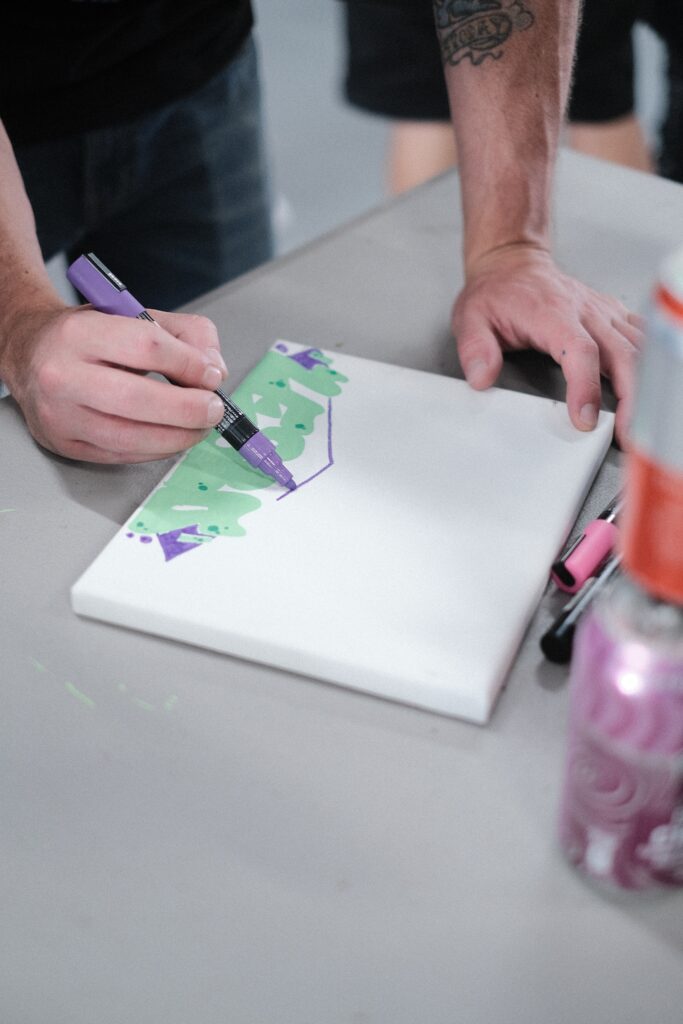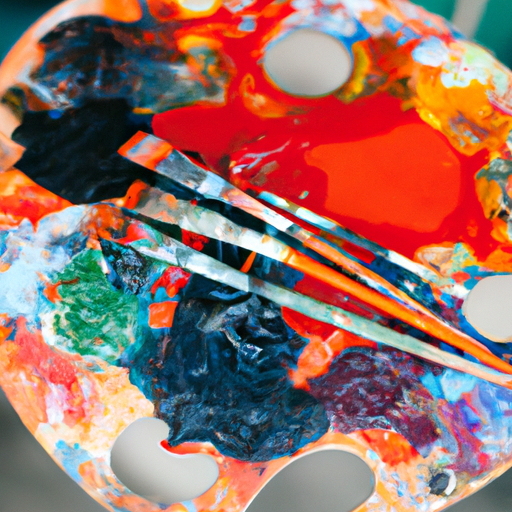In this article, we will explore the question of whether acrylic paint is the same as fabric paint. Many people wonder if they can use their acrylic paint on fabrics or if they need to buy a separate type of paint specifically designed for textiles. By examining the properties and differences between these two types of paint, we aim to provide you with a clear understanding of which one is best suited for your artistic endeavors on fabric. So, let’s dive into the world of acrylic paint and fabric paint and discover if they are truly the same or not.

Properties of Acrylic Paint
Composition
acrylic paint is a versatile medium that consists of pigments suspended in a polymer emulsion. The pigments provide the color, while the polymer emulsion, typically made of acrylic resin, acts as the binder that holds the pigments together. This composition gives acrylic paint its unique characteristics and allows for its application on various surfaces, including canvas, wood, paper, and even fabric.
Color Pigmentation
One of the notable properties of acrylic paint is its exceptional color pigmentation. The pigments used in acrylic paints are typically finely ground, which results in vibrant and concentrated colors. As a result, acrylic paint offers a wide range of colors that can be mixed and layered to achieve various shades and hues. Whether you prefer bold and vibrant colors or subtle and muted tones, acrylic paint can fulfill your artistic vision.
Viscosity
Acrylic paint comes in different viscosities, ranging from thin and fluid to Thick and heavy-bodied. The viscosity of acrylic paint affects its consistency and flow. Thin acrylic paints are suitable for techniques like watercolor painting or airbrushing, while heavy-bodied acrylics are ideal for impasto or textured paintings. The ability to control the paint’s viscosity allows artists to achieve a wide range of effects and textures in their artwork.
Opacity
Opacity refers to how much light can pass through a layer of paint, determining its transparency or opacity. Acrylic paint offers a range of opacities, including transparent, translucent, and opaque. Transparent acrylics allow underlying layers to show through, while opaque acrylics offer solid coverage. This property gives artists the flexibility to layer colors, create depth, or experiment with different levels of transparency, enhancing the visual impact of their artwork.
Drying Time
Acrylic paint has a relatively fast drying time compared to other types of paint, allowing artists to work quickly and efficiently. The drying time of acrylic paint can vary depending on factors such as the thickness of the paint layer, humidity, and temperature. Generally, acrylic paint dries to the touch within minutes to hours. This quick drying time enables artists to layer colors, make adjustments, and continue working without significant delays.
Properties of Fabric Paint
Composition
Fabric paint, as the name suggests, is specifically formulated for use on textiles and fabrics. It shares some similarities with acrylic paint but also contains additional properties to ensure adhesion and flexibility on fabric surfaces. Like acrylic paint, fabric paint consists of pigments suspended in a binder. However, the binder in fabric paint is designed to withstand repeated washing and maintain its adhesion to fabrics without cracking or peeling.
Specialized Formulation
Unlike acrylic paint, fabric paint goes through a specialized formulation process to optimize its performance on fabrics. The formulation of fabric paint includes additives that enhance its textile adhesion, colorfastness, and flexibility. These additives allow fabric paint to withstand the rigors of laundering, making it suitable for projects such as painting on garments, accessories, or home textiles like pillows or curtains.
Color Pigmentation
Similar to acrylic paint, fabric paint offers a wide range of colors with excellent color pigmentation. The pigments used in fabric paint are specifically chosen to ensure color vibrancy and permanence on fabric surfaces. Moreover, fabric paints often come in sets or collections curated for textile applications, offering a selection of colors that coordinate well and provide artistic freedom to create intricate designs or patterns on fabrics.
Viscosity
The viscosity of fabric paint is formulated to strike a balance between ease of application and adhesion to fabric fibers. Fabric paint is generally thicker than regular acrylic paint to prevent excessive absorption by the fabric, ensuring that the colors remain vivid and do not bleed. The controlled viscosity allows fabric paint to be applied with precision and ease, making it suitable for detailed designs or freehand painting on fabrics.
Opacity
Like acrylic paint, fabric paint also offers a range of opacities. However, due to the nature of fabric surfaces, fabric paint tends to have a more translucent or semi-opaque finish. This allows the texture and weave of the fabric to show through, resulting in a softer and more fabric-like appearance. Fabric paint’s opacity variations make it suitable for creating subtle and delicate designs on fabrics, allowing the underlying fabric to contribute to the overall aesthetic.
Drying Time
Fabric paint generally has a longer drying time compared to acrylic paint. This slower drying time allows artists to work on intricate designs or blend colors on fabric surfaces without the paint drying too quickly. Depending on the brand and specific formulation, fabric paint typically requires several hours to dry completely. It is important to follow the manufacturer’s instructions to ensure proper drying and curing, which helps enhance the paint’s adhesion and durability on fabrics.
Differences in Composition
Acrylic Paint Composition
Acrylic paint, as mentioned earlier, consists of pigments suspended in an acrylic polymer emulsion. The emulsion acts as the binder, holding the pigments together and allowing them to adhere to various surfaces. The composition of acrylic paint gives it excellent adhesive properties and makes it suitable for use on different materials, including fabrics when combined with appropriate mediums. However, when used on fabric without additional preparation, acrylic paint may not adhere as well and may stiffen the fabric.
Fabric Paint Composition
Fabric paint is specifically formulated to adhere to fabric surfaces and to withstand laundering. Apart from pigments, fabric paint contains additional additives that enhance its adhesion, flexibility, and resistance to fading or bleeding. The composition of fabric paint ensures that it remains pliable and soft on fabrics, allowing the painted fabric to retain its drape and texture even after multiple washes. The specialized formulation makes fabric paint a preferred choice for projects involving fabric surfaces.
Versatility and Applicability
Suitability on Different Surfaces
While both acrylic paint and fabric paint can be used on fabric, acrylic paint offers greater versatility when it comes to various surfaces. acrylic paint adheres well to surfaces such as canvas, wood, paper, plastic, and more. Its composition and binder allow it to bond effectively with these materials, offering artists a wide range of creative possibilities. On the other hand, fabric paint is primarily designed for fabric surfaces and may not adhere as effectively to non-fabric materials.
Compatibility with Different Techniques
acrylic paint is compatible with a wide range of painting techniques, from traditional brushwork to abstract pours and mixed media experimentation. Its versatility allows artists to explore various techniques and styles without limitations. Fabric paint, on the other hand, is specifically tailored for textile applications. It excels in techniques such as stenciling, block printing, fabric stamping, and freehand painting on fabrics, where it offers excellent control and adhesion.
Applicability on Different Materials
Acrylic paint’s ability to adhere to a variety of materials makes it a favorite among artists. It can be used on canvas, paper, wood, plastic, metal, and more, allowing artists to create diverse artwork across different mediums. While fabric paint is primarily designed for fabric surfaces, it can also be applied to other materials like leather, synthetic fabrics, or fabric blends. However, it may require additional preparation or special adhesion mediums to ensure optimal results on non-fabric materials.

Color Pigmentation Differences
Effect on Color Intensity
Both acrylic paint and fabric paint offer vibrant and intense colors. However, due to their different compositions and properties, there may be slight variations in color intensity. Acrylic paint, with its finely ground pigments and versatile binder, provides strong, vivid colors that retain their vibrancy even after drying. Fabric paint, while still offering vibrant colors, may appear slightly softer or more subdued on fabric surfaces due to the nature of textile fibers.
Colorfastness on Fabrics
Colorfastness refers to a paint’s ability to retain its color without fading or bleeding over time. Both acrylic paint and fabric paint strive to provide colorfastness, but fabric paint is specifically designed to maintain its vibrancy and adhere to fabric fibers through repeated washes. It undergoes specialized formulation and testing to ensure that the colors remain vibrant, even after exposure to washing agents and prolonged use. Fabric paint’s colorfastness on fabrics makes it ideal for projects that require long-lasting, fade-resistant colors.
Viscosity Variations
Effect on Ease of Application
Acrylic paint offers a range of viscosities, from thin and fluid to thick and heavy-bodied, allowing artists to choose the consistency that suits their preferred application technique. Thin acrylic paints flow smoothly and are suitable for techniques like washes or glazes, while heavy-bodied acrylics retain brushstrokes and are ideal for impasto or textured effects. The ability to adjust viscosity according to the desired effect allows for greater control and ease of application with acrylic paint.
Fabric paint, however, is formulated with a controlled viscosity that strikes a balance between ease of application and preventing excessive absorption by the fabric. The slightly thicker consistency of fabric paint minimizes bleeding and allows for precise application, making it easier to achieve intricate designs or precise lines on fabric surfaces.
Influence on Drying Time
Viscosity plays a role in the drying time of both acrylic paint and fabric paint. Generally, thicker and heavier-bodied paints tend to have longer drying times as they require more time to cure and dry completely. This slower drying time allows artists to work on their artwork for extended periods, blending colors or adding fine details without the paint drying too quickly on the palette or fabric surface. Thinner acrylic paints and fabric paints with a controlled viscosity tend to dry relatively faster.

Opacity Variation
Degree of Opacity in Acrylic Paint
Acrylic paint offers a range of opacities, including transparent, translucent, and opaque. Transparent acrylics allow light and underlying layers to show through, creating a sense of depth and luminosity. Translucent acrylics provide some coverage while allowing light to pass through, resulting in a softer and more ethereal appearance. Opaque acrylics offer solid coverage, concealing underlying layers and creating bold and vivid statements.
Degree of Opacity in Fabric Paint
Fabric paint, while offering some variation in opacity, tends to have a more translucent or semi-opaque finish. As fabric surfaces have texture and weave, fabric paint’s slight transparency allows the texture of the fabric to show through, creating a softer and more fabric-like appearance. This property makes fabric paint ideal for projects where a softer, more delicate effect is desired, such as painting on clothing or textiles for home decor.
Differences in Drying Time
Factors Affecting Drying Time
The drying time of both acrylic paint and fabric paint can vary depending on several factors. The thickness of the paint layer, humidity, temperature, and airflow all influence the drying time. Thicker paint layers will naturally take longer to dry, while thin layers will dry relatively faster. Higher humidity levels can extend drying times, as moisture in the air slows down the evaporation of water in the paint. Warmer temperatures and good airflow facilitate faster drying, while cooler temperatures may prolong the drying process.
Notable Drying Time Differences in Acrylic and Fabric Paints
Despite these factors, acrylic paint generally has a faster drying time compared to fabric paint. Acrylic paint typically dries to the touch within minutes to hours, allowing artists to work on successive layers or make adjustments with minimal waiting time. On the other hand, fabric paint has a longer drying time, usually requiring several hours to dry and cure completely. Artists working on fabric projects need to consider this longer drying time when planning their artwork and allow for adequate drying and curing before handling or laundering the fabric.

Effects on Fabric Softness
Acrylic Paint and Fabric Softness
When acrylic paint is applied directly to fabric without additional preparation or blending mediums, it can affect the fabric’s softness. Acrylic paint, when dry, can make the fabric feel stiff and less pliable. However, by adding fabric mediums or using the appropriate ratio of acrylic paint to fabric conditioner, artists can minimize the impact on fabric softness. These additives help maintain the fabric’s softness while still allowing the paint to adhere effectively.
Fabric Paint and Fabric Softness
Fabric paint, designed specifically for fabric surfaces, strives to maintain the fabric’s softness and flexibility. The specialized additives in fabric paint allow it to bond effectively with fabric fibers without significantly altering the fabric’s texture. As a result, fabrics painted with fabric paint retain their original softness, making them comfortable to wear or use. This property makes fabric paint an excellent choice for textile projects that require both artistic expression and fabric functionality.
Preparation Requirements
Prepping for Acrylic Painting
Preparing for acrylic painting involves ensuring a clean, dust-free surface and proper priming if necessary. If painting on a canvas or board, it is recommended to apply a suitable acrylic gesso primer to enhance adhesion and prevent the paint from seeping into the porous surface. Additionally, artists may choose to mix mediums with their acrylic paint to achieve specific effects or extend drying time.
Prepping for Fabric Painting
Preparation for fabric painting begins with selecting an appropriate fabric for the desired project. Fabrics should be prewashed, free from sizing or fabric softeners, and thoroughly dried to remove any residual chemicals that may hinder paint adhesion. It is advisable to work on a flat, stable surface and use a backing material, such as cardboard or freezer paper, to prevent paint from bleeding through onto the working surface or other layers of fabric. Fabric paints may also require heat-setting or curing methods as recommended by the manufacturer to ensure proper adhesion and permanence on fabric surfaces.
In conclusion, while both acrylic paint and fabric paint share some similarities in their composition, they have distinct properties that make them suitable for different purposes. Acrylic paint offers versatility in its application, compatibility with various surfaces and techniques, and faster drying times. On the other hand, fabric paint’s specialized formulation ensures adhesion, flexibility, colorfastness, and softness on fabric surfaces. Understanding these differences allows artists to choose the most appropriate paint for their specific artwork or fabric projects, ensuring optimal results and lasting beauty.




